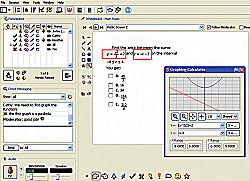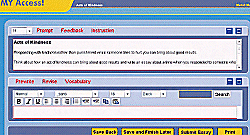A Virtual Treasure Trove
##AUTHORSPLIT##<--->
The educational opportunities offered online can help students explore ancientMayan ruins—or the reasons behind a poor essay grade.
TODAY IT’S POSSIBLE for you to:
- explore the British Museum, paying particular attention to the Egyptian exhibits
- ask the curator about the museum’s responsibilities to countries from which artifacts are acquired
- discuss with students from around the world their ideas about the provenance of relics
- write an essay expressing your opinion on the topic and have it graded instantaneously
 When I say “today,” I mean today you can do all that online— the exploration, the Q and A, the discussion, and the essay grading. Our world has simultaneously shrunk and expanded, and the exchange of teaching and learning can happen faster than everbefore.
When I say “today,” I mean today you can do all that online— the exploration, the Q and A, the discussion, and the essay grading. Our world has simultaneously shrunk and expanded, and the exchange of teaching and learning can happen faster than everbefore.
Polycom is a major player in that world. Specialists in communication— integrating video, voice, data, and internet strategies to provide, among other things, videoconferencing for students, the company recently partnered with the Global Nomads Group (GNG), an international educational organization, to launch the Pulse program, a series of interactive videoconferences connecting high school students with each other andwith subject experts.
David Macquart, the company’s director of communications, explains how it works: GNG sends out a mailing telling subscriber schools which topics are coming up. Interested schools sign up for an event. The company sends out preparatory material, then students participate in two videoconferences: one in which they discuss the designated topic with other high school students, and another in which they discuss the topicwith experts.
A student moderates the conferences, taking questions from peers and voicing them through a microphone. GNG provides the issue, the content, and the material; Polycom provides the technology.
“The idea,” Macquart says, “is to use technology and videoconferencing to connect kids from different parts of the world. Collaboration and acknowledgment of other cultures is crucial.”
GNG has about 3,500 member schools, many in the rural Midwest. With the Pulse program, students have explored the ancient Jordanian city of Petra and the Mayan ruins of Copan in Honduras, and they’ve spoken directly with young people living in those areas. They’ve discussed HIV/AIDS and the war in Iraq, and they’ve experienced those issues through the eyes and earsof those most directly involved.
“If you scratch my skin,” says Russ Colbert, Polycom’s education market manager, “it’s gonna bleed education.” So he’s a big proponent, for example, of students around the country talking with Holocaust survivors, visiting Mount Rushmore, or strolling through the Los Angeles County Museum of Art—all online. As for the necessary technology, Colbert believes the hardware and software have become more integrated, less complex, and easier to use: “[Teachers] realize they don’t have to become technicians... to use the products easily.”
An Elluminating Technology
For ease of use that approaches magic, take a look at Elluminate Live. The program makes use of two-way audio, direct messaging, live video, closed captioning, user profiles, an interactive whiteboard, application sharing, breakout rooms, polling/quizzing, and file transfer—all in pursuit of real-time online learning and collaboration. The technology works in a computer lab, where each student has a PC and can use the program to collaborate with other students across the country to survey parents about their smoking habits. It works in a classroom, where the teacher can project a webinar onto an interactive whiteboard, and the class can discuss the Civil War with a historian, with the teacher relaying student questions to the host. It works in a conference room, where teachers can share strategies for teaching foreign language with their peers around the world. It works for users with low or high bandwidth— and it works in real time.

ON THE SAME PAGE: Today’s students can connect
with peers, teachers, and subject experts from all over.
And according to Rajeev Arora, Elluminate’s vice president of marketing and strategy, it isn’t complicated. He says a half hour’s training is all that’s needed to use the technology. Also, schools can choose to install the software or have the company host it.
Stan Silverman, director of technology at the New York Institute of Technology, says he uses the program “for everything….Every day is a new discovery of the application.” Silverman runs NYIT’s Technology Based Learning Systems, which supports online course activities for about 5,000 students and training for K-12 educators. The most requested training is for Elluminate Live. “When we do a demonstration, they go into shock,” he says. “[They say], ‘I never imagined the technology had matured to this level.’”
Silverman calls the program an “intellectual enabler.” He says it’s important not to merely plug what you’re doing into Elluminate Live; it’s critical to know the application’s capabilities and to make the most of them.
Access Granted
It’s become standard to use eLearning for visiting faraway places and talking with people who are often otherwise inaccessible. But how far can the technology be taken? How about using it to replace human activities entirely and do them faster or better? What aboutfor, say, grading essays?
Behold My Access, made by Vantage Learning. My Access scores essays and provides diagnostic feedback to motivate students to revise and improve their writing. Harry Barfoot, the company’s vice president of marketing, says three-quarters of a million students currently use My Access, and the results are impressive. For example, in Los Angeles’ Birmingham High School, 81 percent of the students who used the program while preparing for the California High School Exit Examination passed the test, whereas students who didn’t use theprogram had a 46 percent pass rate.

GO, SPEED GRADER: Automated grading systems have
been shown to be as effective at essayappraising as
classroom teachers—while working at an
extraordinarily faster pace.
“We digitize the thinking into software,” says Barfoot. That’s done with the company’s automated essay-scoring tool, IntelliMetric, which emulates the process carried out by human scorers, but with distinct advantages: It uses the same standards essay after essay, it’s not biased by an essay’s point of view, and it uses multiple judgments based on a variety of information sources.
In fact, in scores of studies pitting the system against “expert” essay graders, IntelliMetric agreed with the average expert score more often than any single expert’s score did. IntelliMetric was also found to be consistent with other appraisals of the same writing, including teacher judgments, SAT scores, and multiple-choice writing tests.
Students who used the program before a state exam nearly doubled the pass rate of students who didn’t.
Barfoot cites the technology’s advantages: 1) It frees up teachers. A teacher may spend several minutes on an essay; IntelliMetric can do a whole batch in seconds. 2) It motivates students. The program sees 12 to 15 revisions to a writing prompt such as “Do you believe thatviolence on TV influences violence in society?” because students get feedback so quickly. 3) With the home version, it’s always available. As Barfoot says, “We are, to a great extent, a 24-hour society.”
And that gets to the root of eLearning’s appeal. It’s the availability of these programs that frees students and teachers from the restrictions of conventional instruction—delivering multicultural experiences, more engagement, and ultimately, higher student achievement.
Neal Starkman is a freelance writer based in Seattle.
This article originally appeared in the 04/01/2007 issue of THE Journal.